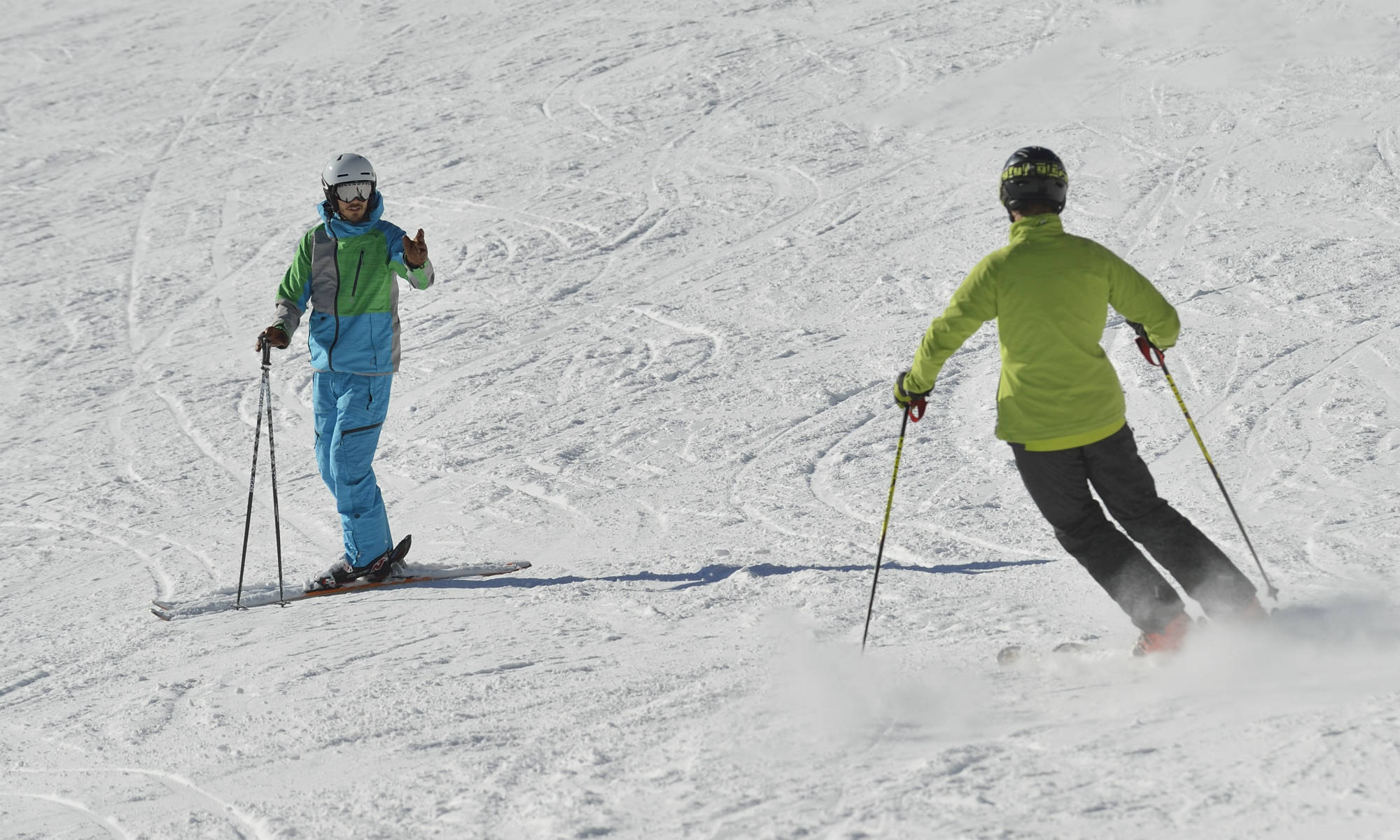
Ready, set, go … with the parallel turn! After the basic technique of the snow plough, the next exciting challenge awaits skiing beginners: the parallel turn. Here you swing through the snow while maintaining your skis in parallel position. This way, you glide down the ski slope elegantly and much faster than in plough position.
The experts at checkyeti will show you how to transition from the basic techniques to the parallel turn, what to keep in mind and how best to practise the parallel turn.
-
- From snow plough to parallel turn
- How to: the correct technique
- The correct use of the ski sticks
- Practice makes perfect
From snow plough to parallel turn

- The first step in learning to ski is the plough or the plough turn. Those who have perfected it and feel confident on skis can move on to the next step: the parallel turn, which is more dynamic and which costs less energy. Here, the skis are continuously kept in a parallel position, which allows for much more speed.Since the parallel turn is a more advanced technique, it is recommended to take lessons from a qualified ski instructor. The most success is usually achieved during private lessons, as the instructor can take into consideration the individual skill level of the participant, build on it, and develop personalised exercises.As parallel turns cause skiers to glide much faster than plough turns, many beginners don’t transition directly from the snow plough to the parallel turn. Instead, they are eased into the new technique with the help of intermediate steps. A good way to practise is by gliding downhill sideways while trying to keep the skis in parallel position and completing the turns in plough position. The size of the plough turns can be gradually decreased until the skis are almost parallel to one another. Furthermore, it is advisable to start practising at a slower speed and on flatter slopes. As time passes, one can start going faster and one can dare to conquer some steeper slopes.This exercise can be repeated as often as it takes to feel safe enough to keep the skis in a parallel position when turning.The ski resort of Samoëns is only an hour’s drive from Geneva airport and offers 135km of blue runs, making it ideal for beginners:
How to: the correct technique

In contrast to the snow plough, the parallel turn requires the skis to be kept, as the name suggests, in parallel position. The skier’s legs are kept slightly apart in order to ensure sufficient mobility. It is also important to keep one’s knees, as well as one’s hips and ankles slightly bent, so as to maintain a stable posture and to absorb any bumps on the slope.
To initiate a parallel turn, the skier begins by tilting the skis towards the valley – i.e. the pressure is taken off the edges that are pressed hillside, whereby the angle between the skis and the piste is reduced and the skis automatically turn downwards in the direction of the valley. Here, the skier shifts his or her body weight onto the downhill ski: The knees are then pushed back towards the mountain and the weight is shifted onto the downhill ski. That way, the ends of the skis drift apart and the turn is ridden out. In this instance, it is particularly important that both skis, which are kept in a parallel position, are turned at the same time.
The better one can carry out the correct motion, the more fluid the parallel turn looks. As soon as the technique for parallel turning has been perfected, the movements melt into one another and it becomes harder to tell where one turn ends and the next one starts.
The friendly ski resort of Obergurgl is located an hour away from Innsbruck and has plenty of excellent blue slopes for skiers to practice their newly-learned parallel turns:
The correct use of the ski sticks
 Using ski sticks can help support your rhythm and balance[/caption
Using ski sticks can help support your rhythm and balance[/caption
- The correct use of skiing sticks can support the correct execution of the parallel turn. The sticks help maintain one’s rhythm when turning and to stabilise one’s body. That’s why using ski sticks properly is taught as of this skill level during ski lessons.During a parallel turn, the correct use of the ski sticks starts at the beginning of the turn. At every tilt of the skis before a turn, the stick on the side of the valley comes into use. Basically, the skis turn around the stick. When using ski sticks, it isn’t necessary to stick them deep into the snow. Lightly touching the ground is sufficient.
Practice makes perfect
With a couple of simple, preliminary exercises, skiers can get used to the motion of the parallel turn. Ski instructor Jenny demonstrates some helpful exercises:
Sliding sideways
A good way to practise the tilting of the skis is by sliding sideways. This exercise is ideal for gaining a feeling for the edges of one’s skis. Here, the skier stands in starting position, parallel to the slope, while the knees are pressed towards the mountain. If the knees are now moved downhill, towards the valley, the edges of the skis are lifted out of the snow and the skier slides down the slope sideways. To stop, one simply reverts back to the starting position and pushes one’s knees towards the mountain again.
The “Garland”
Another exercise to practise tilting is the ‘Garland’. Here, one first glides along the slope with both skis kept in parallel position. Then, the skis are tilted: The knees are pressed towards the slope and the pressure is focussed on the edges of the skis. Next, the edges are released again to let the skis slide again. If the skier presses his or her knees towards the mountain again, thereby tilting the skis again, the skis automatically curve towards the slope and the skier makes a small turn. To know if the exercise was done correctly, you can check to see whether there is a pattern in the form of a garland in the snow behind you.
Practising the correct posture
To be able to perfectly execute the parallel turn, the correct posture is essential. The correct posture for one’s upper body can be trained by holding the ski sticks horizontally in both hands and trying to keep them parallel to the slope at all times. The necessary weight shifts can be practised by skiing on one ski. Here, the pressure is placed on the downhill ski while simultaneously lifting the back end of the other ski from the ground.

For me, skiing is the perfect combination of spending time with family and friends, exercise, and outdoor bliss. What more would you want?
